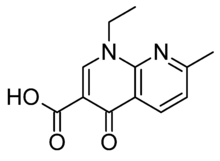Nalidixic acid
 | |
| Clinical data | |
|---|---|
| AHFS/Drugs.com | Consumer Drug Information |
| Pregnancy category |
|
| Routes of administration | Oral |
| ATC code | |
| Legal status | |
| Legal status |
|
| Pharmacokinetic data | |
| Protein binding | 90% |
| Metabolism | Partially Hepatic |
| Elimination half-life | 6-7 hours, significantly longer in renal impairment |
| Identifiers | |
| |
| CAS Number | |
| PubChem CID | |
| DrugBank | |
| ChemSpider | |
| UNII | |
| KEGG | |
| ChEBI | |
| ChEMBL | |
| ECHA InfoCard |
100.006.241 |
| Chemical and physical data | |
| Formula | C12H12N2O3 |
| Molar mass | 232.235 g/mol |
| 3D model (JSmol) | |
| |
| |
| (verify) | |
Nalidixic acid (tradenames Nevigramon, Neggram, Wintomylon and WIN 18,320) is the first of the synthetic quinolone antibiotics.
In a technical sense, it is a naphthyridone, not a quinolone: its ring structure is a 1,8-naphthyridine nucleus that contains two nitrogen atoms, unlike quinoline, which has a single nitrogen atom.[1]
Synthetic quinolone antibiotics were discovered by George Lesher and coworkers as a byproduct of chloroquine manufacture in the 1960s.[1] Used clinically from 1967.[1]
Nalidixic acid is effective primarily against gram-negative bacteria, with minor anti-gram-positive activity. In lower concentrations, it acts in a bacteriostatic manner; that is, it inhibits growth and reproduction. In higher concentrations, it is bactericidal, meaning that it kills bacteria instead of merely inhibiting their growth.
It has historically been used for treating urinary tract infections, caused, for example, by Escherichia coli, Proteus, Shigella, Enterobacter, and Klebsiella. It is no longer clinically used for this indication in the USA as less toxic and more effective agents are available.
It is also a tool in studies as a regulation of bacterial division. It selectively and reversibly blocks DNA replication in susceptible bacteria. Nalidixic acid and related antibiotics inhibit a subunit of DNA gyrase and topoisomerase IV and induce formation of cleavage complexes.[2] It also inhibits the nicking-closing activity on the subunit of DNA gyrase that releases the positive binding stress on the supercoiled DNA.
Adverse effects
Hives, rash, intense itching, or fainting soon after a dose may be a sign of anaphylaxis. Common adverse effects include rash, itchy skin, blurred or double vision, halos around lights, changes in color vision, nausea, vomiting, and diarrhea. Nalidixic acid may also cause convulsions and hyperglycaemia,[3] photosensitivity reactions,[4] and sometimes haemolytic anaemia,[5][6] thrombocytopenia[7] or leukopenia. Particularly in infants and young children, has been reported occasionally increased intracranial pressure.[8][9][10]
Overdose
In case of overdose the patient experiences headache, visual disturbances, balance disorders, mental confusion, metabolic acidosis and seizures.[11]
Spectrum of bacterial susceptibility and resistance
Aeromonas hydrophila, Clostridium and Haemophilus are generally susceptible to nalidixic acid, while other bacteria such as Bifidobacteria, Lactobacillus, Pseudomonas and Staphylococcus are resistant.[12]
See also
References
- 1 2 3 Emmerson AM, Jones AM (May 2003). "The quinolones: decades of development and use" (pdf). The Journal of Antimicrobial Chemotherapy. 51 Suppl 1 (Suppl 1): 13–20. doi:10.1093/jac/dkg208. PMID 12702699.
- ↑ Pommier, Y.; Leo, E.; Zhang, H.; Marchand, C. (2010). "DNA topoisomerases and their poisoning by anticancer and antibacterial drugs". Chem. Biol. 17: 421–433. doi:10.1016/j.chembiol.2010.04.012. PMID 20534341.
- ↑ Fraser AG, Harrower AD (Dec 1977). "Convulsions and hyperglycaemia associated with nalidixic acid". British Medical Journal. 2 (6101): 1518. doi:10.1136/bmj.2.6101.1518. PMC 1632822. PMID 589309.
- ↑ Ramsay CA (Aug 1973). "Photosensitivity from nalidixic acid". Proceedings of the Royal Society of Medicine. 66 (8): 747. PMC 1645105. PMID 4733958.
- ↑ Gilbertson C, Jones DR (Nov 1972). "Haemolytic anaemia with nalidixic acid". British Medical Journal. 4 (5838): 493. doi:10.1136/bmj.4.5838.493-a. PMC 1786728. PMID 4653901.
- ↑ Tafani O, Mazzoli M, Landini G, Alterini B (Oct 1982). "Fatal acute immune haemolytic anaemia caused by nalidixic acid". British Medical Journal. 285 (6346): 936–7. doi:10.1136/bmj.285.6346.936-a. PMC 1499997. PMID 6811074.
- ↑ Meyboom RH (Oct 1984). "Thrombocytopenia induced by nalidixic acid". British Medical Journal. 289 (6450): 962. doi:10.1136/bmj.289.6450.962. PMC 1443179. PMID 6435742.
- ↑ Boréus LO, Sundström B (Jun 1967). "Intracranial hypertension in a child during treatment with nalidixic acid". British Medical Journal. 2 (5554): 744–5. doi:10.1136/bmj.2.5554.744. PMC 1841777. PMID 6025983.
- ↑ Kremer L, Walton M, Wardle EN (Nov 1967). "Nalidixic acid and intracranial hypertension". British Medical Journal. 4 (5577): 488. doi:10.1136/bmj.4.5577.488-a. PMC 1748506. PMID 6055749.
- ↑ Deonna T, Guignard JP (Sep 1974). "Acute intracranial hypertension after nalidixic acid administration". Archives of Disease in Childhood. 49 (9): 743. doi:10.1136/adc.49.9.743. PMC 1649016. PMID 4419059.
- ↑ Eizadi-Mood N (Mar 2006). "Nalidixic acid overdose and metabolic acidosis". Cjem. 8 (2): 78. PMID 17175866.
- ↑ "Nalidixic acid spectrum of bacterial susceptibility and Resistance" (PDF). Toku-E. 2011-09-14. Archived from the original (pdf) on 2016-01-10. Retrieved 2012-05-14.
External links
- MedlinePlus DrugInfo medmaster-a682042
- "Nalidixic acid". HealthDigest.org.